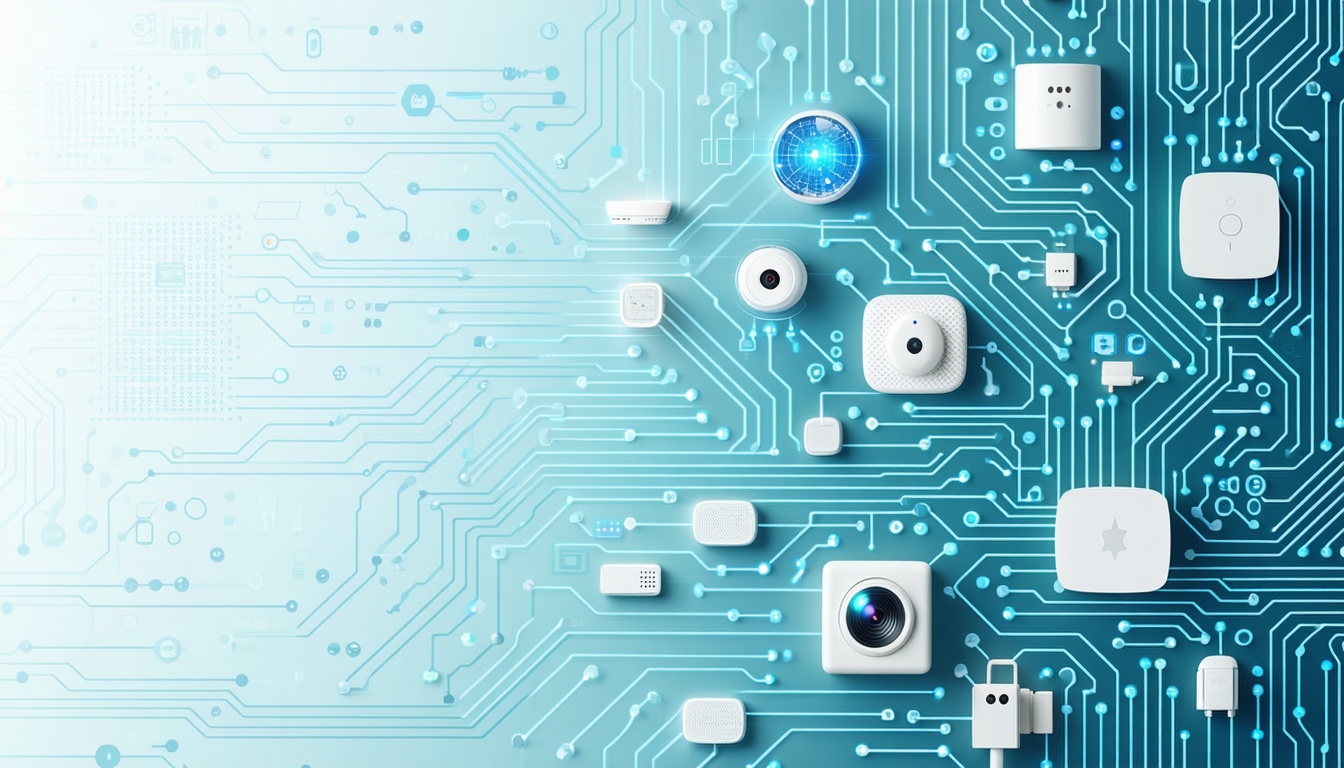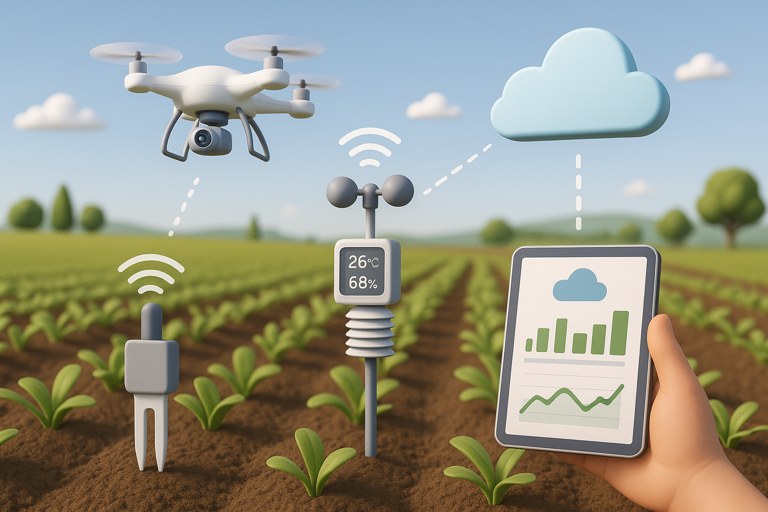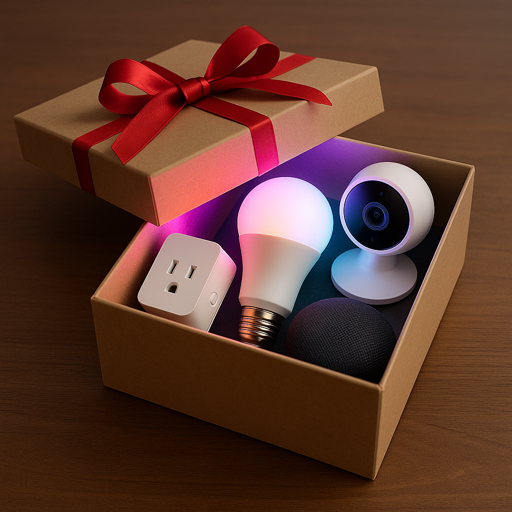This post may contain affiliate links. If you click through and make a purchase, we may earn a commission at no additional cost to you. This helps support our work and allows us to continue providing valuable content. For more information, please see our disclosure policy.

If you’ve ever wondered how different IoT sensor types make everyday processes smoother, you’re not alone. From improving production lines to powering smart homes, these tiny but mighty components are central to modern life. Experts estimate there are already over 15 billion connected devices worldwide, all generating streams of valuable data. When used effectively, this data can help optimize everything from energy use in your house to predicting equipment failures on the factory floor.
In this guide, you’ll learn what IoT sensors are, why they matter, the most common IoT sensor types and how to pick the right ones for your needs.
What Are IoT Sensors?
IoT sensors act like digital bridges between the physical world and the Internet. They detect changes in the environment (such as temperature, pressure, motion or light) and transmit that information to a central system for analysis.
Thanks to the Internet of Things (IoT), nearly any object can become “smart” once fitted with a sensor and connectivity. Today’s IoT applications span countless industries, from agriculture and healthcare to retail and manufacturing.
- Agriculture: Soil moisture and temperature sensors help farmers water efficiently and boost crop yields.
- Healthcare: Wearables track vital signs like heart rate or oxygen levels, enabling doctors to monitor patients remotely.
- Manufacturing: Machine sensors monitor status in real time, predicting maintenance needs before breakdowns occur.
The Three Key Functions of IoT Sensors
- Data capture: Detect changes in the environment (temperature shifts, motion detection, gas levels).
- Data transmission: Send readings to a device or gateway over Wi-Fi, Bluetooth, cellular networks or specialized IoT networks like LoRaWAN.
- Data interpretation: Analyze data in the cloud or at the edge to produce insights, automate actions or trigger alerts.
Together, these steps form real-time feedback loops. For example, a smart thermostat sensor measures room temperature, sends the data to the cloud and quickly gets back instructions to adjust heating for comfort and efficiency.
Why Use IoT Sensors?
You might be thinking: “Okay, but is it really worth the effort to set up sensors everywhere?” If you’re looking for improved efficiency, cost savings or deeper insights, the answer is usually yes.
Here are a few benefits of incorporating sensors into your processes:
- Automation: Sensors enable tasks to run on autopilot, from turning off lights in empty rooms to adjusting manufacturing lines without manual intervention.
- Predictive maintenance: By constantly tracking performance data, you can spot small problems before they become big breakdowns. This means less downtime and fewer expensive surprises.
- Cost reduction: Automating routine checks and reducing energy usage can lower bills, whether in a busy office or a large scale industrial facility.
- Improved insights and adaptability: With data streaming in real-time, you can make quicker, evidence based decisions. You’ll see patterns faster and pivot when needed.
- Regulatory compliance: Many industries require constant monitoring to meet safety or environmental standards. Sensors ensure you’re always in the loop.
- Remote monitoring: Remote monitoring allows you to manage systems across different locations, all from a single dashboard.
If you manage a busy factory, sensors can optimize everything from production speed to worker safety. If you’re simply looking to build a smarter home, sensors can alert you to a window left open or a water leak in the basement.
Core IoT Sensor Types
Not all sensors are created equal. Some measure temperature, others detect motion and many do much more. Below is a quick-reference table, followed by details of the most common IoT sensor types and their applications.
| Sensor Type | What It Measures | Typical Uses | Example Technologies |
|---|---|---|---|
| Temperature | Heat/cold | Smart buildings, healthcare, food transport | Thermistors, RTDs, thermocouples |
| Proximity | Presence of nearby objects | Retail, parking, automation | Ultrasonic, infrared, capacitive |
| Pressure | Force per unit area | Vehicles, aircraft, leak detection | MEMS pressure sensors, TPMS |
| Motion | Movement in an area | Security, energy management | PIR, ultrasonic, microwave |
| Image | Visual data | Security, machine vision, vehicles | CMOS/CCD cameras |
| Accelerometer | Linear acceleration | Wearables, smartphones, vehicles | MEMS accelerometers |
| Air Quality | Gas/particulate levels | Smart cities, offices | CO₂, VOC, PM sensors |
| Biomedical | Vital signs | Healthcare, fitness wearables | Heart rate, SpO₂, glucose monitors |
| Level | Quantity of liquids/solids | Tanks, silos, fluid management | Ultrasonic, capacitive level sensors |
| Humidity | Moisture in air | Agriculture, HVAC | Resistive/capacitive humidity sensors |
| Gyroscope | Orientation/rotation | Drones, robotics, smartphones | MEMS gyroscopes |
| Optical | Light intensity | Smart lighting, phone displays | Photodiodes, phototransistors |
| Chemical/Gas | Specific gases/compounds | Industrial safety, homes | CO, ammonia, VOC sensors |
| Vibration | Oscillations or mechanical movement | Industrial machines, predictive maintenance, structural monitoring | Piezoelectric sensors, MEMS accelerometers |
| Sound / Acoustic | Noise levels, sound waves, ultrasonic signals | Noise monitoring, leak detection, voice assistants | Microphones, ultrasonic sensors |
| GPS / GNSS | Global positioning, location tracking | Fleet management, agriculture, asset tracking | GPS, GLONASS, Galileo, BeiDou receivers |
| Current / Voltage | Electrical parameters: current, voltage, power | Smart meters, energy monitoring, equipment maintenance | Hall effect sensors, current transformers |
Temperature Sensors
Temperature sensors, as the name implies, measure how hot or cold something is. They appear in everything from simple thermostats in our homes to complex industrial systems that require precise heat management. These devices are crucial in:
- Smart buildings: Adjust heating or cooling automatically.
- Healthcare settings: Monitor patient temperature or keep medical supplies at safe thresholds.
- Food transport: Track temperature in reefer trucks or warehouses to protect goods.
Common types include thermistors, thermocouples, and RTDs (resistor temperature detectors). Thermocouples are popular in industrial settings, while thermistors are often found in home appliances.
Proximity Sensors
Proximity sensors detect whether an object is near without physical contact. They do this by sending out a signal (infrared, ultrasonic or electromagnetic) and then reading reflections or interruptions of that signal. If you’ve ever seen a store door automatically swing open, that’s a proximity sensor at work. Retailers also use them in cashier-less systems to detect products taken off shelves.
Pressure Sensors
Pressure sensors monitor force per unit area and are essential in automotive, aircraft and industrial manufacturing systems. For instance, a tire pressure monitoring system (TPMS) in a car notifies you when a tire needs air. In aircraft, sensors can ensure cabin pressure remains at safe levels. They’re also used for leak detection in water pipelines or gas lines.
Motion Sensors
These detect movement in defined zones and are often used for security or energy saving solutions. When you walk into a public restroom and the lights switch on automatically, that’s likely a passive infrared (PIR) sensor. Ultrasonic and microwave sensors are alternatives, working by bouncing pulses off nearby objects and looking for changes in the environment.
Image Sensors
Cameras are image sensors that capture and convert visuals into digital signals. While security cameras might be the most familiar example, image sensors also power machine vision in industrial sorting, smart refrigerators that scan groceries and autonomous vehicles that detect traffic conditions.
Accelerometer Sensors
Accelerometers measure changes in velocity, providing data about movement and orientation. They’re a staple in smartphones (helping the screen orient correctly), in fitness trackers (measuring your steps) and in car airbags (detecting sudden deceleration to deploy safety systems).
Air Quality Sensors
Air quality sensors measure gases and particulates, such as CO₂ or PM2.5. Many smart cities install these sensors around town to track pollution, letting local authorities send alerts if levels get too high. They’re also common in offices that want to ensure optimal indoor air quality for employees.
Biomedical Sensors
These measure vital signs like heart rate, blood pressure or oxygen saturation. If you wear a fitness watch that tracks your heart rate, you’re already using a biomedical sensor. In hospitals, they provide continuous patient monitoring with real-time alerts for doctors.
Level Sensors
Level sensors detect the amount of material in containers, from water tanks to grain silos. They’re crucial in industrial process control, ensuring that machines run properly and resources don’t overflow or run low. Ultrasonic or capacitive sensors are often used to measure liquid or solid levels without direct contact.
Humidity Sensors
Humidity sensors gauge the amount of water vapor in the air. In agriculture, they help adjust irrigation based on current moisture levels. In HVAC (heating, ventilation and air conditioning) systems, these sensors maintain comfortable indoor humidity and prevent mold growth.
Gyroscope Sensors
Remember picking up your smartphone and tipping it to rotate a racing game? That happens thanks to a gyroscope sensor. Drones and robotics also depend on gyroscopes to maintain stability and orientation in flight.
Optical Sensors
Optical sensors measure light intensity, often used for auto-brightness in your phone screen or in street lights that turn on when it gets dark. They convert light into electronic signals, enabling real-time adaptation to lighting conditions.
Chemical and Gas Sensors
These sensors detect hazardous substances like carbon monoxide, ammonia or volatile organic compounds (VOCs). Industries use them to maintain safe working conditions, while homeowners rely on them in carbon monoxide detectors to warn of dangerous leaks.
Vibration Sensors
Vibration sensors detect oscillations or irregular movements in machines, structures or vehicles. In industrial IoT (IIoT), they are critical for predictive maintenance, as changes in vibration patterns often reveal early signs of wear, imbalance or faults in motors and equipment. These sensors also appear in structural monitoring (for example, tracking vibrations in bridges or buildings to ensure safety).
Sound / Acoustic Sensors
Acoustic sensors measure sound waves or vibrations in the air. They’re increasingly important in smart cities, where they track environmental noise levels, and in industrial settings where ultrasonic microphones can detect gas or water leaks before they become dangerous. On the consumer side, microphones in IoT devices also enable your favorite voice assistants and smart speakers to respond to spoken commands.
GPS / GNSS Sensors
GPS and other global navigation satellite system (GNSS) sensors provide location data for IoT devices. They are central to fleet tracking, smart agriculture (for precision planting and harvesting) and asset management in logistics. Unlike accelerometers or gyroscopes, which measure motion and orientation, GNSS sensors deliver absolute location, making them vital for mapping and geofencing applications.
Current / Voltage Sensors
Electrical sensors measure current, voltage or power consumption in circuits. They play a critical role in smart meters, energy efficient buildings and predictive maintenance for electrical systems. By monitoring real-time power usage, these sensors help reduce waste, improve safety and identify failing components before they cause costly downtime.

Smart Data Collection with IoT Sensors
Sensors alone won’t transform your processes if you’re not prepared to handle the vast amounts of data they generate. Solid data gathering processes are key to transforming basic readings into actionable insights.
The IoT Data Flow
- Collection at the device layer: A sensor picks up data, such as temperature or motion.
- Communication layer: Often handled by wireless protocols like Wi-Fi, Bluetooth, LoRaWAN or cellular, which transmit readings to a gateway.
- Edge layer processing: Sometimes you need real-time analysis at the edge (closer to the sensor), which reduces latency and network load.
- Processing in the cloud or data center: This is where sophisticated analytics, machine learning and long term storage usually happen.
- Presentation layer: Finally, the results appear in dashboards, mobile apps or automated triggers that put the data to practical use.
Best Practices for Efficient Data Handling
- Prioritize security: Encrypt data both at rest and in transit to protect against unauthorized access.
- Clean and validate sensor data: Remove duplicates, correct errors and standardize formats. Messy data skews results and leads to poor decisions.
- Use gateways: An IoT gateway manages different protocols and can do initial data processing, which helps handle large traffic volumes securely.
- Balance edge and cloud storage for efficiency: Not all data needs to travel to the cloud. Storing and processing some information closer to where it’s generated (at the edge) helps reduce latency, save bandwidth and keep critical systems responsive in real time. For example, a factory vibration sensor can flag anomalies locally to trigger an instant machine shutdown, while also sending summarized data to the cloud for long term trend analysis.
Scaling IoT Sensor Networks
Even if your sensor network starts small, it might expand quickly once you see the benefits. Projections suggest there could be over 30 billion IoT devices by 2030. A scalable approach helps you stay nimble as you add new sensors.
Embrace Modular Design
You don’t want to replace your entire system whenever you add a new monitoring capability. Choosing modular components and flexible gateways upfront makes it easier to swap sensors, integrate new protocols or update firmware.
Leverage Analytics and AI
Data from sensors is gold for machine learning models that can spot anomalies and predict future outcomes. In manufacturing, advanced analytics can catch slight irregularities in a production line, prompting early intervention that saves hours and money. For city planners, AI can optimize traffic lights based on real-time vehicle counts to reduce congestion.
Cost Control
When you scale, your connectivity and storage costs can skyrocket. If you’re deploying thousands of sensors, consider usage based billing models. Zipit, for example, helps customers structure plans so that end consumers cover increased utilization as more sensors come online. This approach ensures you’re not caught off guard by surging expenses.
Factor in Maintenance
No matter how advanced your sensors are, they still need occasional calibration and firmware updates. Plan a maintenance schedule based on vendor recommendations and watch for signs of wear or inaccurate readings. That might mean testing pressure sensors in vehicles every few months or recalibrating temperature sensors in a refrigerated warehouse to ensure accurate readings.
Measuring What Matters Most
At the heart of every connected device lies a simple idea – measure something important and act on it. IoT sensors are the tools that make this possible, capturing everything from temperature and air quality to movement and orientation. On their own, these readings may seem small, but together they create the valuable insights that power smarter homes, safer workplaces, more efficient factories and healthier cities.
As IoT adoption accelerates at an unprecedented rate, choosing the right mix of sensor types will determine how well systems deliver value, whether that’s saving energy, reducing downtime or keeping people safe. With the right sensors in place and a strong data strategy behind them, businesses and individuals alike can transform ordinary environments into intelligent, responsive systems.
In the end, the future of IoT isn’t just about more devices. It’s about measuring what matters most and using that knowledge to make better decisions every day.

